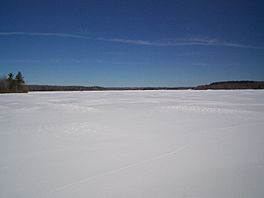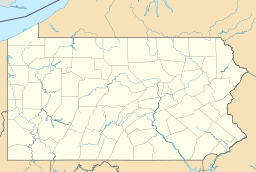Stillwater Lake (Pennsylvania) facts for kids
Quick facts for kids Stillwater Lake |
|
|---|---|

Stillwater Lake in the winter
|
|
| Location | Coolbaugh Township / Tobyhanna Township, Monroe County, Pennsylvania, US |
| Coordinates | 41°07′19″N 75°25′26″W / 41.1219°N 75.4239°W |
| Type | artificial lake |
| Primary inflows | Dotter's Run Stream Hawkeye RunStream Pocono Summit Creek |
| Primary outflows | Tunkhannock Creek |
| Basin countries | United States |
| Max. length | 0.87 mi (1.4 km) |
| Max. width | 1.24 mi (2.0 km) |
| Surface area | 315 acres (127 ha) |
| Average depth | 4.7 ft (1.4 m) |
| Max. depth | 8 ft (2.4 m) |
| Water volume | 1,480 acre⋅ft (1,830,000 m3) |
| Surface elevation | 1,811 ft (552 m) |
| Islands | 6 |
Stillwater Lake is a special kind of lake called a reservoir. It covers about 315 acres (1.3 square kilometers). This lake is found in Pocono Summit, Pennsylvania. It sits high up, at about 1,811 feet (552 meters) above sea level.
Water flows into Stillwater Lake from several streams. These include Dotter's Run, Hawkeye Run, and Pocono Summit Creek. The lake also gets water from underground springs. From Stillwater Lake, the water flows out into Tunkhannock Creek. This creek then leads to Lake Naomi.
Today, Stillwater Lake is home to the Stillwater Estates community. It also hosts Camp Minsi. This camp is a facility owned by the Boy Scouts of America's Minsi Trails Council.
Contents
The Lake's Interesting Past
The area where Stillwater Lake is now was once a big swamp. The Native American people who lived there had a name for it. They called it "Klampeechen Chuppecat" in their Lenape language. This name meant "deep, dark swamp."
How the Lake Was Created
In the 1870s, many trees were cut down in the Poconos. The swamp was cleared away to make a new, man-made lake. This lake was built to help move cut timber. The logs could float downstream to sawmills. A dam was built to control the water. Three small streams and underground springs filled this new lake. It was first called Tunhannock Lake. Logs were sent down Tunkhannock Creek to Lake Naomi. Then they went to a sawmill on Lake Pocono.
The Rise of the Ice Industry
After the forests were mostly cut down, businesses looked for new ways to make money. They turned to the ice industry. From the late 1880s to the 1930s, ice harvesting was very important in the Poconos. Many ice companies started up. They collected ice from the shallow lakes.
The Pocono Mountain Ice Company, led by Samuel Rubel, became the biggest ice company. They bought many smaller companies. Large ice houses were built around Stillwater Lake. These buildings stored huge blocks of ice. You can still see parts of these old buildings today. They are on the south and east sides of the lake.
Pennsylvania was a major ice producer. It was third in the country, after Maine and New York. The state used about 1 million tons of ice each year. This ice was cut from lakes and rivers. Besides Stillwater Lake, the Pocono Mountain Ice Company harvested ice from other lakes. These included Saylor's Lake, Trout Lake, Lake Naomi, and Pocono Lake.
Ice workers on the lake earned 30 cents an hour. Those working in the icehouse earned 35 cents an hour. They moved 300-pound (136 kg) blocks of ice. The Pocono Mountain Ice Company hired over 500 men during the busiest times.
The End of Ice Harvesting
In the 1930s, new technology changed everything. Refrigerators became common. This made harvesting ice from lakes less and less profitable. Eventually, the ice companies closed down. But they still owned large areas of land.
New Life for the Lake Area
In 1949, Samuel Rubel and his company gave most of the land around Stillwater Lake to the Boy Scouts of America. This land went to the Bethlehem Area Council, which is now the Minsi Trails Council. The rest of the land was sold to developers. In the 1960s, it became Stillwater Lake Estates. This community has about 1,000 lots. It offers a beach, community center, playground, and tennis courts.
Keeping the Dam Safe
In 2002, the Pennsylvania Department of Environmental Protection (DEP) looked at the dam on Stillwater Lake. They said it was a "B2 High Hazard Dam." This meant it needed repairs to be safe. Money was approved in 2006 to fix the dam.
In 2008, the Minsi Trails Council, who owns the dam, agreed to a plan with the DEP. They set a timeline for the repairs. The Scouts worked hard to get the money released. They needed it to fix the dam and save their camp. The repairs would also protect the surrounding area.
In late 2009, $1.31 million was released for the dam upgrade. Construction started in August 2010. It finished in the spring of 2011. The project cost almost $2 million. The new dam has a new spillway and gate. It also has a strong 400-foot (122-meter) concrete wall. The new dam was officially opened in July 2011.
Gallery





